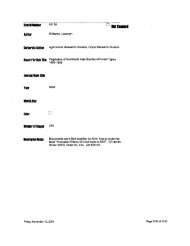Item ID Number - Special Collections
Item ID Number - Special Collections
Item ID Number - Special Collections
You also want an ePaper? Increase the reach of your titles
YUMPU automatically turns print PDFs into web optimized ePapers that Google loves.
-1-<br />
SttMAHY OF RESEARCH ACCOMPLISHED<br />
I. Studies relating to the affects of pesticides on plankton.<br />
It has been suggested that the varying resistance of marine phytoplankton<br />
to effects of chlorinated hydrocarbons could have far-reaching<br />
effects in terms of phytoplankton population balance. Studies in this<br />
laboratory have also shown varied growth inhibition of planktonic bluegreen<br />
algae by chlorinated hydrocarbons. TABLE 1 shows the effects of<br />
aldrin, dieldrin, and endrin on growth rates (generations per 2U hr.)<br />
of Anacystis nidulans (freshwater species) and Agme'nellum quadrupllcatum<br />
(marine species).It is noticeable that generally the marine Isolate is<br />
more tolerant than the freshwater isolate. This may be due to the influence<br />
of the growth medium on the insecticide. The toxiclty of a<br />
pesticide in aquatic environments may vary according to the physical<br />
characteristics of water.<br />
Although much variation is noted in the data, the general trend<br />
indicates both algae are tolerant to these insecticides except at concentration*<br />
higher than reported in natural waters. Also notable is<br />
the sensitivity of A. nidulana to dieldrin, an isomer of<br />
TABLE 1<br />
Growth Response of Agmenellum quadruplicate* and Anacystis nidulans<br />
to Aldrin*, Dieldrin, and<br />
"""^<br />
Aldrin Dieldrin Endrin<br />
A. quadru-A. A. quadru-A^ A. quadru-AT<br />
ppb pllcatum* 5 nidulans 0 plicatum nidulans plicatum nidulans<br />
950<br />
U75<br />
95<br />
19 0.2<br />
Control<br />
6.2 * 0.7<br />
7.1 * 0.5<br />
6.6 * 1.2<br />
6.8 * 0.3<br />
6.U * i.o<br />
6.6 * 0.5<br />
6.U * O.U<br />
6.7 * 0.2<br />
6.8 * 0.5<br />
7.1 * O.U<br />
7.2 i 0.3<br />
6.S * O.U<br />
5.8 i 0.9<br />
6.0 - 0.8<br />
6.0 - 1.0<br />
6.5 - 0.7<br />
5.3 * 1.2<br />
6.2 i 0.9<br />
3.2*0.8<br />
3.9*1.5<br />
6.9*0.6<br />
7.2*0.9<br />
6.7*1.3.<br />
3.5 * 0.9<br />
U.8 * 1.5<br />
U.9 *2.2<br />
5.6 * 1.3<br />
*0.3<br />
6.9*0.6 6.6 * 0.5<br />
2.2 * 0.7<br />
3.2 *1.0<br />
6.3 * 0.3<br />
6.6 * O.U<br />
7.0 * 0.5<br />
6.6 * O.U<br />
Concentrations for aldrin 910, U55, 91, 18 and 0.2 ppb.<br />
Values reported as number of generations per 2U hours, represents mean of<br />
3 to 5 replicate cultures<br />
Aajaenellum quadrupllcatum (strain FR-6), Anacystic nidulans (strain TX20)<br />
In preliminary experiments the growth response of these two algae<br />
was also tested against phenylaercuric acetate (FHA), an algicide and<br />
fungicide once used extensively in 'Industry. The results are summarized<br />
in TABLE 2.
















